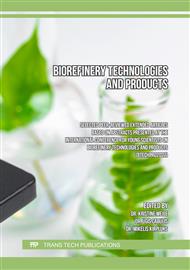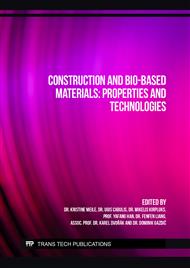[1]
Danish, B. Zhang, Z. Wang, and B. Wang, Energy production, economic growth and CO2 emission: evidence from Pakistan,, Nat. Hazards, vol. 90, no. 1, p.27–50, 2018,.
DOI: 10.1007/s11069-017-3031-z
Google Scholar
[2]
European Comission, A European Green Deal,, A European Green Deal, Eur. Comm., (2021).
Google Scholar
[3]
A. M. Papadopoulos, State of the art in thermal insulation materials and aims for future developments,, Energy Build., vol. 37, no. 1, p.77–86, Jan. 2005,.
DOI: 10.1016/j.enbuild.2004.05.006
Google Scholar
[4]
F. Asdrubali, F. D'Alessandro, and S. Schiavoni, A review of unconventional sustainable building insulation materials,, Sustain. Mater. Technol., vol. 4, no. 2015, p.1–17, 2015,.
DOI: 10.1016/j.susmat.2015.05.002
Google Scholar
[5]
S. Liuzzi, S. Sanarica, and P. Stefanizzi, Use of agro-wastes in building materials in the Mediterranean area: A review,, Energy Procedia, vol. 126, p.242–249, 2017,.
DOI: 10.1016/j.egypro.2017.08.147
Google Scholar
[6]
C. Rabbat, S. Awad, A. Villot, D. Rollet, and Y. Andrès, Sustainability of biomass-based insulation materials in buildings: Current status in France, end-of-life projections and energy recovery potentials,, Renew. Sustain. Energy Rev., vol. 156, 2022,.
DOI: 10.1016/j.rser.2021.111962
Google Scholar
[7]
Central Statistical Bureau of Latvia, Agriculture of Latvia. Collection of Statistics, 2020.,.
Google Scholar
[8]
N. Dikmen and S. T. E. Ozkan, Unconventional Insulation Materials,, in Insulation Materials in Context of Sustainability, InTech, 2016.
DOI: 10.5772/63311
Google Scholar
[9]
R. Ahmadi, B. Souri, and M. Ebrahimi, Evaluation of wheat straw to insulate fired clay hollow bricks as a construction material,, J. Clean. Prod., vol. 254, May 2020,.
DOI: 10.1016/j.jclepro.2020.120043
Google Scholar
[10]
M. Ali et al., Thermal and acoustic characteristics of novel thermal insulating materials made of Eucalyptus Globulus leaves and wheat straw fibers,, J. Build. Eng., vol. 32, Nov. 2020,.
DOI: 10.1016/j.jobe.2020.101452
Google Scholar
[11]
E. M. A. Elbashiry, J. Chen, W. Tuo, Y. Ren, and Z. Guo, Review of the pretreatment methods for wheat straw building materials,, J. Reinf. Plast. Compos., vol. 37, no. 1, p.35–48, 2018,.
DOI: 10.1177/0731684417730442
Google Scholar
[12]
G. Han, J. Deng, S. Zhang, P. Bicho, and Q. Wu, Effect of steam explosion treatment on characteristics of wheat straw,, Ind. Crops Prod., vol. 31, no. 1, p.28–33, Jan. 2010,.
DOI: 10.1016/j.indcrop.2009.08.003
Google Scholar
[13]
T. Schnabel, H. Huber, A. Petutschnigg, and A. Jäger, Analysis of plant materials pre-treated by steam explosion technology for their usability as insulating materials,, Agron. Res., vol. 17, no. 2010, p.1191–1198, 2019,.
Google Scholar
[14]
A. Nawirska‐olszańska et al., Qualitative and quantitative assessment of buckwheat husks as a material for use in therapeutic mattresses,, Int. J. Environ. Res. Public Health, vol. 18, no. 4, p.1–19, Feb. 2021,.
DOI: 10.3390/ijerph18041949
Google Scholar
[15]
I. G. Shaikhiev, S. V. Sverguzova, R. Z. Galimova, and A. S. Grechina, Using wastes of buckwheat processing as sorption materials for the removal of pollutants from aqueous media: a review,, in IOP Conference Series: Materials Science and Engineering, Oct. 2020, vol. 945, no. 1.
DOI: 10.1088/1757-899x/945/1/012044
Google Scholar
[16]
G. N. Edgars Cubars, Evaluation of reed resources in Latvia and analysis of its use for energy production,, 2012, [Online]. Available: www.jeb.co.in.
Google Scholar
[17]
S. Wichmann and J. F. Köbbing, Common reed for thatching-A first review of the European market,, Ind. Crops Prod., vol. 77, p.1063–1073, 2015,.
DOI: 10.1016/j.indcrop.2015.09.027
Google Scholar
[18]
M. Komulainen et al., Reed energy possibilities of using the Common Reed for energy generation in Southern Finland. Turku University of Applied Sciences, (2008).
Google Scholar
[19]
A. Bakatovich, F. Gaspar, and N. Boltrushevich, Thermal Insulation Material Based on Reed and Straw,, SSRN Electron. J., p.1–25, 2022,.
DOI: 10.2139/ssrn.4018843
Google Scholar
[20]
F. Vitrone, D. Ramos, V. Vitagliano, F. Ferrando, and J. Salvadó, All-lignocellulosic fiberboards from giant reed (Arundo donax L.): Effect of steam explosion pre-treatment on physical and mechanical properties,, Constr. Build. Mater., vol. 319, no. December 2021, 2022,.
DOI: 10.1016/j.conbuildmat.2021.126064
Google Scholar
[21]
F. Gao, B. Li, B. Ren, B. Zhao, P. Liu, and J. Zhang, Effects of residue management strategies on greenhouse gases and yield under double cropping of winter wheat and summer maize,, Sci. Total Environ., vol. 687, p.1138–1146, 2019,.
DOI: 10.1016/j.scitotenv.2019.06.146
Google Scholar
[22]
M. Palumbo, J. Avellaneda, and A. M. Lacasta, Availability of crop by-products in Spain: New raw materials for natural thermal insulation,, Resour. Conserv. Recycl., vol. 99, p.1–6, 2015,.
DOI: 10.1016/j.resconrec.2015.03.012
Google Scholar
[23]
M. Andzs, R. Tupciauskas, A. Veveris, L. Andze, J. Abolins, and J. Gravitis, Biomass conversion into blow-in heat insulation materials by steam explosion,, Holzforschung, vol. 71, no. 7–8, p.641–644, Jul. 2017,.
DOI: 10.1515/hf-2016-0188
Google Scholar
[24]
EN 15103, Solid biofuels - Determination of bulk density., European Committee for Standardization, Brussels, p.1–12, (2009).
Google Scholar
[25]
A. Abdou and I. Budaiwi, The variation of thermal conductivity of fibrous insulation materials under different levels of moisture content,, Constr. Build. Mater., vol. 43, p.533–544, 2013,.
DOI: 10.1016/j.conbuildmat.2013.02.058
Google Scholar
[26]
R. Stapulionienė, S. Vaitkus, S. Vėjelis, and A. Sankauskaitė, Investigation of thermal conductivity of natural fibres processed by different mechanical methods,, Int. J. Precis. Eng. Manuf., vol. 17, no. 10, p.1371–1381, 2016,.
DOI: 10.1007/s12541-016-0163-0
Google Scholar



